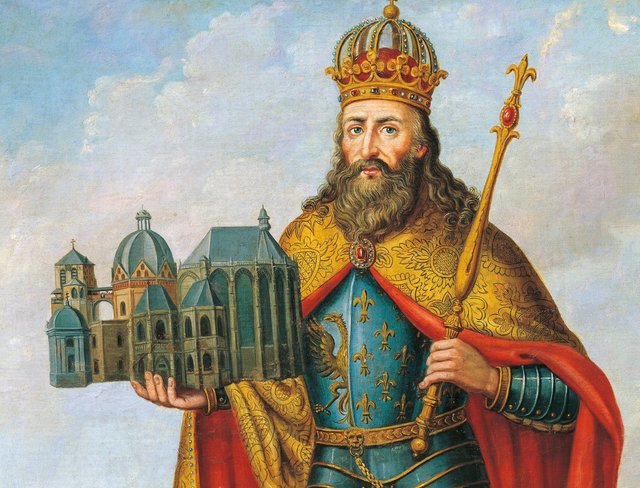Emperors - 04 - Charlemagne (742-814)

Charlemagne or Charles the Great was the king of the Franks, (the period of reign 748-814 A. D.) and Holy Roman Emperor (period of reign 800-814 A. D.).
He was the eldest son of Pepin-II or ‘Pepin the Short’, the first Carolingian king of the Franks. It is reported that Charlemagne was born in Gaul (present France).
When his father died in 768 he inherited half the Frankish Kingdom and annexed the remainder on his brother Carloman’s death, that took place in 771. Within a short period he built a large empire.
Charlemagne first invaded Italy, and did the same for a second time and took the Lombard throne in 773.
During the period of 773 and 804 he embarked on a long and brutal conquest of Saxony, and annexed Bavaria in 788.
He defeated the Avars of the middle Danube between 791 and 804.
Charlemagne launched few campaigns against the Moors who held a part of the Christian Spain under their control. The famous ‘Song of Roland’ tells of the heroic deeds of him and his knights.
In 800 Pope Leo III consecrated him as Emperor, in the great church of St. Peter’s, Rome, on Christmas Day, thus reviving the concept of the Roman Empire. This remarkable incident confirmed the separation of the west from the Eastern Byzantine Empire.
A famous historian thus describes the famous scene:
“At last the fullness of time was come, and Charles, attended by all his courtiers, and by the citizens of Rome, went to pay his devotions on the morning of Christmas Day in the great church of St Peter. They mounted up from the banks of the Tiber by the long colonnade which stretched all the way from the castle of St Angelo to the threshold of St Peter’s. They ascended the thirty five steps to the platform on which the Pope and all the great officers of his household stood waiting to receive them. Charles himself ‘in great shape and gesture proudly eminent’ with his yellow locks tinged with grey and with some furrows ploughed in his cheeks by the toil of twenty Saxon campaigns, towered above the Swarthy Shaven clerics who surrounded the Pope.”
Charlemagne encouraged the intellectual awakening that was called the ‘Carolingian Renaissance’ and contributed a lot for literature, arts, crafts and architecture.
He set up a strong central authority and maintained a firm provincial control through a large number of able court officials.
His central aim was Christian reform both of church and laity, and was convinced that God had made him emperor to undertake this holy mission.
@originalworks @minnowpond @minnowsupport @benjo @farihelper @morwhale @dorabot @SteemGigs @dropahead